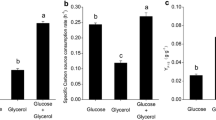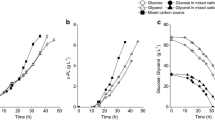Abstract
Using glucose–glycerol mixed carbon source has proved to be an effective strategy for ε-poly-l-lysine (ε-PL) production with rapid cell growth and much higher ε-PL productivity. In this study, we attempt to focus on key enzymes and intracellular energy cofactors to reveal the underlying mechanisms involved in such significant improvements. The activities of key enzymes involved in the pentose phosphate pathway, TCA cycle, anaplerotic pathway and the aspartate family amino acid biosynthesis pathway as well as ε-PL synthetase showed overall enhancement with the mixed carbon source, especially in the late stages of fermentation, compared with those in either glucose or glycerol single carbon sources. Moreover, the intracellular cofactors in terms of NADH and ATP kept higher formation and consumption rates in the mixed carbon source, respectively, throughout batch fermentation. As a result, Streptomyces sp. M-Z18 could be accelerated in cell growth and precursor l-lysine biosynthesis in the mixed carbon source, thus finally shortening fermentation time and enhancing ε-PL productivity. Understanding this process will provide information for the rational regulation of the metabolism network of the quantative production of ε-PL by metabolic engineering.







Similar content being viewed by others
References
El-Sersy, N. A., Abdelwahab, A. E., Abouelkhiir, S. S., Abou-Zeid, D. M., & Sabry, S. A. (2012). Journal of Basic Microbiology, 52(5), 513–522.
Yamanaka, K., Maruyama, C., Takagi, H., & Hamano, Y. (2008). Nature Chemical Biology, 4(12), 766–772.
Yamanaka, K., & Hamano, Y. (2010). Amino-acid homopolymers occurring in nature. In Y. Hamano (Ed.) Biotechnological production of poly-epsilon- l -lysine for food and medical applications, vol. 15, (pp. 61–75). Springer Berlin.
Shih, I. L., Shen, M. H., & Van, Y. T. (2006). Bioresource Technology, 97(9), 1148–1159.
Kobayashi, K., & Nishikawa, M. (2007). World Journal of Microbiology and Biotechnology, 23(7), 1033–1036.
Li, S., Li, F., Chen, X. S., Wang, L., Xu, J., Tang, L., & Mao, Z. G. (2012). Applied Biochemistry and Biotechnology, 166(2), 414–423.
Li, S., Tang, L., Chen, X. S., Liao, L. J., Li, F., & Mao, Z. G. (2011). Journal of Industrial Microbiology and Biotechnology, 38(4), 557–563.
Shih, I. L., & Shen, M. H. (2006). Enzyme and Microbial Technology, 39(1), 15–21.
Kahar, P., Iwata, T., Hiraki, J., Park, E. Y., & Okabe, M. (2001). Journal of Bioscience and Bioengineering, 91(2), 190–194.
Jia, S.R., Wang, G.L., Sun, Y.F., and Tan, Z.L. (2009). Conference thesis, Tianjin University of Science and Technology, Tianjin, China.
Bankar, S. B., & Singhal, R. S. (2010). Bioresource Technology, 101(21), 8370–8375.
Liu, Y., Zhang, Y. G., Zhang, R. B., Zhang, F., & Zhu, J. (2011). Current Microbiology, 62(1), 152–158.
Kim, Y. S., Lee, J. H., Kim, N. H., Yeom, S. J., Kim, S. W., & Oh, D. K. (2011). Applied Microbiology and Biotechnology, 90(2), 489–497.
Peacock, L., Ward, J., Ratledge, C., Dickinson, F. M., & Ison, A. (2003). Enzyme and Microbial Technology, 32(1), 157–166.
Nishikawa, M., & Ogawa, K. (2002). Applied and Environmental Microbiology, 68(7), 3575–3581.
Hiraki, J., Hatakeyama, M., & Morita, H. (1998). Seibutu Kougaku Kaishi, 76, 487–493.
Chen, X. S., Ren, X. D., Dong, N., Li, S., Li, F., Zhao, F. L., Tang, L., Zhang, J. H., & Mao, Z. G. (2012). Bioprocess and Biosystems Engineering, 35(3), 469–475.
Tang, Z., Xiao, C., Zhuang, Y., Chu, J., Zhang, S., Herron, P. R., Hunter, I. S., & Guo, M. (2011). Enzyme and Microbial Technology, 49(1), 17–24.
Bramwell, H., Nimmo, H. G., Hunter, L. S., & Coggins, J. R. (1993). Biochemistry Journal, 293(1), 131–136.
Mukhopadhyay, B., & Purwantini, E. (2000). Biochimica et Biophysica Acta, 1475(3), 191–206.
Krupa, O. C., & Vannucci, D. (2003). Polar Biology, 26(7), 452–457.
Chen, X. S., & Mao, Z. G. (2013). Applied Biochemistry and Biotechnology, 170(1), 185–197.
Myung, S., Wang, Y., & Zhang, Y. H. P. (2010). Process Biochemistry, 45(12), 1882–1887.
Bhattacharyaa, S., Schiavonea, M., Gomesb, J., & Bhattacharya, S. K. (2004). Journal of Biotechnology, 111(2), 203–217.
Cichna, M., Raab, M., Daxecker, H., Griesmacher, A., Muller, M. M., & Markl, P. (2003). Journal of Chromatography B, 787(2), 381–391.
Hong, P., Liu, H. W., Jin, G. H., Li, Y., & Yang, K. S. (2002). Chinese Journal of Sports Medicine, 21(1), 57–60 (in Chinese).
Sunya, S., Gorreta, N., Delvigned, F., Uribelarrea, J. L., & Molina-Jouve, C. (2012). Journal of Biotechnology, 157, 379–390.
Zhu, Y., & Yang, S. T. (2004). Journal of Biotechnology, 110, 143–157.
Bankar, S. B., & Singhal, R. S. (2013). RSC Advances, 3, 8586–8603.
Hamano, Y., Nicchu, I., Shimizu, T., Onji, Y., Hiraki, J., & Takagi, H. (2007). Applied Microbiology and Biotechnology, 76, 873–882.
Ghorbel, S., Kormanec, J., Artus, A., & Virolle, M. J. (2006). Journal of Bacteriology, 188(2), 677–686.
Acknowledgments
This work was supported by the National Natural Science Foundation of China (31301556), the Scientific and Technical Supporting Program of Jiangsu (BE2012616), the Jiangsu province "Collaborative Innovation Center for Advanced Industrial Fermentation" industry development program, and the Priority Academic Program Development of Jiangsu Higher Education Institutions, and the 111 Project (111-2-06).
Author information
Authors and Affiliations
Corresponding authors
Rights and permissions
About this article
Cite this article
Zeng, X., Chen, XS., Ren, XD. et al. Insights into the Role of Glucose and Glycerol as a Mixed Carbon Source in the Improvement of ε-Poly-l-Lysine Productivity. Appl Biochem Biotechnol 173, 2211–2224 (2014). https://doi.org/10.1007/s12010-014-1026-8
Received:
Accepted:
Published:
Issue Date:
DOI: https://doi.org/10.1007/s12010-014-1026-8




